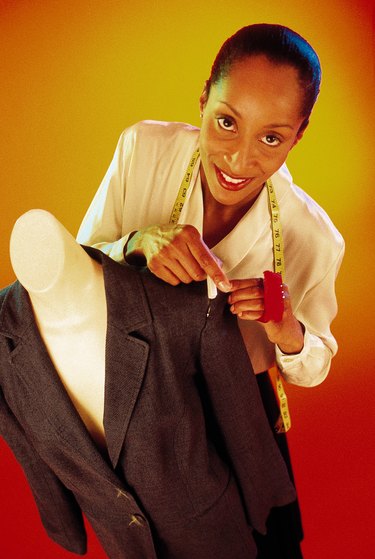Things You'll Need
Suit pattern
Fashion fabric
Lining fabric
Matching thread
Zipper
Buttons
Pins
Measuring tape
Interfacing
Shears
Iron
Ironing board

Making your own tailored suit can be an arduous undertaking, but the results are always impressive. For far less than you'd spend on buying a mediocre ready-to-wear suit and having a tailor rush through the job, you can purchase a few yards of high-quality fabric, thread and trims, and create a suit that fits you perfectly. While it is quite helpful to have some garment-sewing experience, if you work carefully and follow the directions, you still end up with a fine handcrafted suit.
Step 1
Choose a pattern for the items you want to make. Many pattern companies offer two-piece suit pattern sets with a jacket and slacks, but some offer separates. If you want to make a three-piece suit, you may have to purchase a separate pattern set for the vest, as companies generally offer patterns for vests in sets with ties or shirts or blouses.
Video of the Day
Step 2
Select a fabric for your suit and for the lining. You should choose a woven fabric with a natural fiber content for the fashion, or outer, fabric. Polyester and its blends are inexpensive, but do not breathe well, which can be a problem in the summer heat. Wool blends are priced mid-range, but can last indefinitely with proper care. Cashmere is high-end in the price scale, but creates a beautiful suit. Many lining fabrics are polyester blends, but for slightly more you can purchase silk lining fabric which breathes much better.
Step 3
Measure yourself. Most patterns are sold by the chest size and sleeve length for men, or top and bottom sizes for women. If you are unfamiliar with measuring yourself, you may want someone to assist you with it, so the measurements are accurate.
Step 4
Pin the pattern pieces to the fashion and lining fabrics, as well as to the interfacing. Interfacing is used to reinforce or stiffen certain pieces of a garment, such as a collar or waistband. Pin where the pattern notes, such as on a fold line or a doubled piece of fabric, to enable cutting multiple pieces at the same time.
Step 5
Cut the fabric pieces out along the lines for the size you chose. Mind any suggested seam allowances if they are not included in the pattern lines. If your fabric is one that may unravel, use pinking shears to cut the fabric; in particular, many lining fabrics such as acetate or satin are prone to unraveling.
Step 6
Pin the fabric pieces to each other according to your pattern's instructions. Order of construction is crucial in suits, so read the instructions carefully before you begin sewing, and again at each step to ensure accuracy.
Step 7
Stitch the fabric pieces together as directed, but do not insert the lining yet. Try on the shell of the jacket and slacks. Note where pieces need to be shortened, narrowed, sloped or darted. An assistant may be helpful at this juncture to ensure proper fit in the areas you cannot see yourself, such as the center back jacket seam, or seam in the center back of the slacks.
Step 8
Adjust the fit as necessary, and mirror those adjustments on the jacket lining. If you make the jacket smaller, but leave the lining as-is, you end up with bunching in the lining fabric, particularly in the sleeves and back of the jacket. Follow the instructions for inserting the lining. This process can be confusing, as it often requires leaving a gap in the stitching of the center back lining and flipping the entire jacket right-side-out through this seam, which can be a bit nerve-wracking. Follow the instructions closely for this step to lessen confusion.
Tip
If you use a pricey fabric, make a "muslin," or test garment, made out of a cheap fabric. This assists you in working out any problems in fit, without worry of ruining your high-end fabric.
Ask a professional tailor to measure you if you are unfamiliar with measuring yourself, or there is no one around to help you.
Press each seam before and after sewing to prevent puckering or uneven seams.
Video of the Day